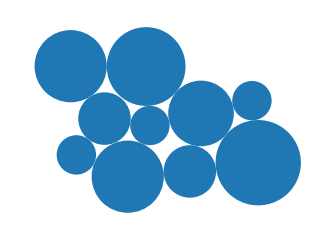在Matplotlib (圆形包装)中制作不重叠的气泡图
在Matplotlib (圆形包装)中制作不重叠的气泡图
提问于 2017-09-09 14:12:17
目前,我正试图在Matplotlib中制作一个气泡图,其中气泡不重叠,所以在图表中填充圆圈/气泡,类似于这。
我认为可能有用的东西:
- 使用x= 1,y=1绘制第一个数据点
- 通过计算气泡半径随机绘制其他数据点,给出标量值,以避免重叠。
但我一直未能真正落实,亦找不到任何资料。
回答 2
Stack Overflow用户
回答已采纳
发布于 2017-09-09 18:12:24
以下是一种蛮力的方法。
您可以首先将所有的圆圈放置在一个网格上,网格间距的大小是任何圆的最大半径的两倍。

然后,让圆圈进行随机游走,并检查每一步,如果这些圆柱体的“势能”变小,并且所得到的位置是有效的(即没有重叠)。
if (e < self.E and self.isvalid(i)):作为一个“势”,我们可以简单地使用一个平方径向函数。
self.p = lambda x,y: np.sum((x**2+y**2)**2)守则:
import numpy as np
import matplotlib.pyplot as plt
# create 10 circles with different radii
r = np.random.randint(5,15, size=10)
class C():
def __init__(self,r):
self.N = len(r)
self.x = np.ones((self.N,3))
self.x[:,2] = r
maxstep = 2*self.x[:,2].max()
length = np.ceil(np.sqrt(self.N))
grid = np.arange(0,length*maxstep,maxstep)
gx,gy = np.meshgrid(grid,grid)
self.x[:,0] = gx.flatten()[:self.N]
self.x[:,1] = gy.flatten()[:self.N]
self.x[:,:2] = self.x[:,:2] - np.mean(self.x[:,:2], axis=0)
self.step = self.x[:,2].min()
self.p = lambda x,y: np.sum((x**2+y**2)**2)
self.E = self.energy()
self.iter = 1.
def minimize(self):
while self.iter < 1000*self.N:
for i in range(self.N):
rand = np.random.randn(2)*self.step/self.iter
self.x[i,:2] += rand
e = self.energy()
if (e < self.E and self.isvalid(i)):
self.E = e
self.iter = 1.
else:
self.x[i,:2] -= rand
self.iter += 1.
def energy(self):
return self.p(self.x[:,0], self.x[:,1])
def distance(self,x1,x2):
return np.sqrt((x1[0]-x2[0])**2+(x1[1]-x2[1])**2)-x1[2]-x2[2]
def isvalid(self, i):
for j in range(self.N):
if i!=j:
if self.distance(self.x[i,:], self.x[j,:]) < 0:
return False
return True
def plot(self, ax):
for i in range(self.N):
circ = plt.Circle(self.x[i,:2],self.x[i,2] )
ax.add_patch(circ)
c = C(r)
fig, ax = plt.subplots(subplot_kw=dict(aspect="equal"))
ax.axis("off")
c.minimize()
c.plot(ax)
ax.relim()
ax.autoscale_view()
plt.show()

由于这种方法的随机游走特性,找到解决方案需要一些时间(在本例中为10秒);当然,您可以使用参数(主要是步骤1000*self.N的数目,直到解决方案固定为止),看看什么适合您的需要。
Stack Overflow用户
发布于 2020-04-02 11:12:36
您可以尝试circlify包:https://pypi.org/project/circlify/
页面原文内容由Stack Overflow提供。腾讯云小微IT领域专用引擎提供翻译支持
原文链接:
https://stackoverflow.com/questions/46131572
复制相关文章
相似问题

